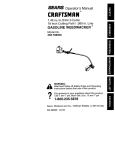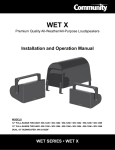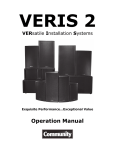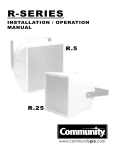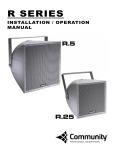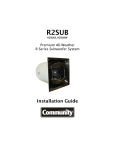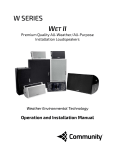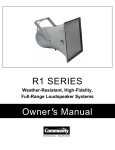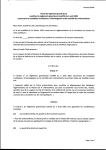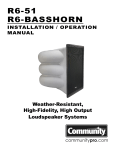Download Community R.5-MAX Operating instructions
Transcript
R SERIES Loudspeakers With Unparalleled Musicality, Superior Voice Projection and Premium Weather Resistance Installation and Operation Manual Models: R.5-MAX and R2-MAX WEATHER-RESISTANT • R-SERIES IMPORTANT SAFETY INSTRUCTIONS RIGGING AND ELECTRICAL SAFETY Always follow these basic safety precautions when using or installing R SERIES loudspeakers and accessories: DANGER: The loudspeakers described in this manual are designed and intended to be ‘flown’ or suspended using a variety of rigging hardware, means, and methods. Installation of loudspeakers should only be performed by trained and qualified personnel. It is strongly recommended that a licensed and certified professional structural engineer approve the mounting design. Severe injury and/or loss of life may occur if these products are improperly installed! All electrical connections must conform to applicable city, county, state, and national (NEC) electrical codes. •Read these instructions prior to assembly. •Keep these instructions for reference. •Heed all warnings. •Follow all instructions, particularly those pertaining to rigging, mounting, hanging and electrical connections. •Only use attachments and accessories that are specified and approved by the manufacturer. •Refer all servicing to qualified service personnel. Servicing is required when the apparatus has been damaged in any way, such as power-supply cord or plug is damaged, liquid has been spilled or objects have fallen into the apparatus, does not operate normally, or has been dropped. The terms caution, warning, and danger may be used in this manual to alert the reader to important safety considerations. If you have any questions or do not understand the meaning of these terms, do not proceed with installation. Contact your local dealer, distributor, or call Community directly for assistance. These terms are defined as: CAUTION: describes an operating condition or user action that may expose the equipment or user to potential damage or danger. WARNING: describes an operating condition or user action that will likely cause damage to the equipment or injury to the user or to others in the vicinity. DANGER: describes an operating condition or user action that will immediately damage the equipment and/or be extremely dangerous or life threatening to the user or to others in the vicinity. These servicing instructions are for use by qualified service personnel only. To reduce the risk of fire or electric shock do not perform any servicing other than that contained in the operating instructions unless you are qualified to do so. DANGER: R SERIES rigging fittings are rated at a Working Load Limit of 100 lbs (45.4 kg) with a 10:1 safety margin. No single rigging fitting should ever be subjected to a load that is greater than 100 lbs. Failure to heed this warning could result in injury or death! IMPORTANT: Refer to the sections on installation and connections later in this manual for additional information on rigging and electrical safety. DANGER: It is possible to experience severe electrical shock from a power amplifier. Always make sure that all power amplifiers are in the “OFF" position and unplugged from an AC Mains supply before performing electrical work. DANGER: It is essential that a safety cable (not supplied) be utilized whenever an R SERIES Loudspeaker is installed. The safety cable must be secured to a suitable load-bearing point separate from the loudspeaker mounting point, with as little slack as possible so as not to develop undue kinetic force if the mounting bracket (yoke) were to fail. Utilize one of the unused threaded mounting points on the enclosure for this purpose. CAUTION: Installation of R SERIES loudspeakers should only be performed by trained and qualified personnel. It is strongly recommended that a licensed and certified professional structural engineer approve the mounting. Severe injury and/or loss of life may occur if this product is improperly installed. Page 2 Installation and Operation Manual R.5-MAX, R2-MAX UNPACKING AND INSPECTION SYSTEM INFORMATION Community R SERIES loudspeakers are engineered and manufactured to be rugged and they are carefully packed in sturdy cartons. Make sure that the number of cartons shown on the freight documents have actually been delivered. It is wise to thoroughly inspect each unit after it has been removed from the packaging, as damage could occur during shipping. PHYSICAL FEATURES / GENERAL DESCRIPTION Please note that once the shipment has left your dealer or the Community factory, the responsibility for damage is always borne by the freight company. If damage has occurred during shipping, you must file a claim directly with the freight company. It’s very important to contact the freight company as soon as possible after receiving your shipment, as most freight companies have a short time limit within which they will investigate claims. Be sure to save the carton and the packing material, as most claims will be denied if these materials are not retained. Your Community dealer and the factory will try to help in any way they can, but it is the responsibility of the party receiving the shipment to file the damage claim. It is always a good idea to retain the carton and packing materials indefinitely, if possible, in the event that the unit may need to be returned to your dealer or distributor for repair. IN THE CARTON Each shipping carton contains the following items: The R.5-MAX and R2-MAX are the premier products in the R SERIES line. They are designed for premium quality music reproduction with very low distortion and high output. The R.5-MAX: This fully passive, true point source loudspeaker produces a very flat frequency response without external equalization. It features a 600W neodymium LF driver with aluminum demodulation ring and a large format 1.4" exit HF driver with copper shorting ring and hybrid resonance damping diaphragm. It is ideal for critical music reproduction in challenging acoustic environment applications indoors or outdoors. Two horn patterns are available: 60° x 60° and 90° x 60°. The R2-MAX delivers the same great pattern control and vocal intelligibility as a standard R2, but with the addition of premium drivers, a signal aligned MF/HF horn, very flat frequency response, higher broadband output, and lower distortion. The R2-MAX features dual 12" 600W neodymium LF drivers with aluminum demodulation rings, large format 1.4" exit HF drivers with copper shorting rings and hybrid, resonance damping diaphragms, and higher output M200HP midrange compression drivers. It is ideal for critical music reproduction in difficult acoustic environments. The R2-MAX is a modern stadium loudspeaker, designed to meet the needs of today’s modern sporting venues. Output is biamp only. Three coverage patterns are available: 60° x 40°, 60° x 60° and 90° x 40°. •One (1) R SERIES loudspeaker •One (1) Steel mounting yoke (pre-installed) •Multi-angle aiming strap [R.5-MAX (1), R2-MAX (2)] •One (1) Installation and operation manual •One (1) Warranty card •Mounting hardware: R.5-MAX (all models): 3/8" x 1-1/4" threaded studs (x3), 3/8" lock washers (x3), 3/8" flat washers (x3), and 3/8"-16 hex nuts (x3). All hardware is stainless steel. R2-MAX (all models): 1/2" hex bolts (2" x3, 1-1/4" x3), 1/2" lock washers (x6), 1/2" flat washers (x7), 1/2" hex nut (x1), and 2" OD rubber gaskets (x5). All hardware is stainless steel. Much of the hardware may be preinstalled on the enclosure. R.5-MAX, R2-MAX R SERIES FEATURES / TECHNOLOGY R-MAX loudspeakers offer numerous features and technologies that provide unprecedented sonic quality and installation flexibility. Some of these include: •Unique full-range high output loudspeakers with advanced passive crossover technology •All models are weather-resistant, UV stabilized and suitable for outdoor direct exposure •Protective steel grilles and mounting brackets are covered with a rugged, zinc-rich epoxy dual-layer powder-coat finish for superior resistance to weather •Stainless steel hardware •R.5-MAX models are available in black, white, or light grey finish and R2-MAX models are available in a light grey finish (standard). Custom colors are also available. Installation and Operation Manual Page 3 PRODUCT FEATURES IDENTIFICATION TYPICAL R.5-MAX FULL-RANGE MODEL Safety Cable Attachment Point: (Utilize empty rigging point. User must supply appropriate fastener and safety cable) Installer to supply hardware for top attachment of strap to yoke Yoke Aiming Strap Grille 3/8"-16 Rigging points (sides and back) 5 Rigging Points (3/8"-16) (sides + back) FRONT Gland Nut / Cable REAR TYPICAL R2-MAX FULL-RANGE MODEL Safety Cable Attachment Point: (Utilize empty rigging point. User must supply appropriate fastener and safety cable) Grille Yoke Angle Securing Straps (5) 1/2"-13 Rigging points HF/MR Connection (white) Gland Nut (5) 1/2"-13 Rigging points LF Connection (black) Gland Nut FRONT Page 4 Suggested Safety Cable Attachment Point (user must supply appropriate 1/2"-13 fastener and safety cable) Installation and Operation Manual REAR R.5-MAX, R2-MAX RIGGING / SUSPENSION AND SAFETY TERMINOLOGY: The terms “rigging", “flying" and “suspension" are often used interchangeably to describe the installation of loudspeaker systems above ground level. None of these terms pertain to, or attempt to describe, the actual method that is used (cables, brackets, chains, etc.). DANGER: The loudspeakers described in this manual are designed and intended to be suspended using a variety of rigging hardware, means, and methods. It is essential that all installation work involving the suspension of these loudspeaker products be performed by competent, knowledgeable persons who understand safe rigging practices. Severe injury and/or loss of life may occur if these products are improperly suspended. DANGER: All rigging fittings and inserts must remain sealed with the included hardware or they must be fitted with properly rated optional mounting hardware. Any missing fasteners will compromise the weather resistance of the enclosure. COMMUNITY RIGGING HARDWARE WARRANTY: Community warrants that its loudspeaker systems and its optional mounting and rigging hardware have been carefully designed and tested. Community loudspeakers may be safely suspended when each loudspeaker model is suspended with Community-manufactured mounting and rigging brackets specifically designed for use with that particular model of loudspeaker. This warranty applies only for use under normal environmental conditions, and when all loudspeakers, component parts, brackets and hardware are assembled and installed in strict accordance with Community’s installation guidelines contained herein. Beyond this, Community assumes no further or extended responsibility or liability, in any way or by any means whatsoever. It is the responsibility of the installer to insure that safe installation practices are followed, and that such practices are in accordance with any and all local, state, federal, or other, codes, conditions, and regulations that may apply to, or govern the practice of, rigging, mounting, and construction work in the relevant geographic territory. Any modifications made to any parts or materials manufactured or supplied by Community shall immediately void all pledges of warranty or surety, related in any way to the safe use of those parts and materials. IMPORTANT NOTES ON RIGGING LOUDSPEAKERS There are three areas of responsibility for rigging loudspeakers. The first is the building structure. Always consult with the building architect or structural engineer to assure the ability of the structure to support the loudspeaker system. The second area of responsibility is the loudspeaker itself. Community certifies its loudspeaker systems and rigging accessories for suspension when they are properly installed according to our published guidelines. The third area of responsibility is everything between the loudspeaker and the building structure and the actual process of installation. The installing contractor assumes this responsibility. Loudspeaker rigging should be performed only by certified rigging professionals using certified rigging hardware chosen for the specific application. Prior to installation, the contractor should present a rigging plan, with drawing and detailed parts list, to a licensed structural engineer (P.E.) or architect for written approval. WARNING: R SERIES rigging fittings are rated at a Working Load Limit of 100 lbs (45.4kg) with a 10:1 safety margin. No single rigging fitting should ever be subjected to a load that is greater than 100 lbs. Failure to heed this warning could result in injury or death! ACCEPTABLE MOUNTING POINT LOADING The mounting points should always be used so that either shear force is applied perpendicular to the direction of and in tight proximity to the mounting hole, or tension force is applied perpendicular to the enclosure surface. See Figure 1 below. DANGER: Use the mounting points only as described above. Do not use them in such a way as to apply sideways leverage to them. Failure to follow this instruction could result in immediate failure of the mounting points resulting in damage to the loudspeaker and serious injury or death to personnel NOT Correct Correct Bracket spaced away from enclosure Yoke tight against enclosure (R.5-MAX) or rubber washer and enclosure (R2-MAX) WARNING NON-COMMUNITY RIGGING HARDWARE: Non-Community hardware used for rigging an R SERIES loudspeaker must be certified by the supplier for such use and must be properly rated for safety. Yoke Custom Bracket Enclosure Figure 1. Mounting point load R.5-MAX, R2-MAX Installation and Operation Manual Page 5 INSTALLATION BEFORE YOU START MOUNT THE R.5-MAX LOUDSPEAKER q Read all instructions and gather tools necessary before starting the installation. Please read all safety instructions and warnings regarding rigging and installation of the loudspeaker. The "q" preceding each step can be used to check off each step as it is completed (or applicable). q Attach the R.5-MAX loudspeaker to the yoke. See Figure 2. The mounting point holes are approximately 7/16" (11mm) deep. The threaded studs used should not extend into the hole more than 3/8" (9.5mm). Lift the loudspeaker into place between the yoke arms. Attach as shown. Support the enclosure until all connections are made. Tighten bolts to finger tight (enough to hold the loudspeaker in position). Every effort has been made to ensure that the information contained in this manual was complete and accurate at the time of printing. However, due to ongoing technical advances, changes or modifications may have occurred that are not covered in this publication. The latest version of this manual is always available at www.communitypro.com. The revision date can be found on the rear cover. The R.5-MAX and the R2-MAX have differing mounting instructions. Please refer to the appropriate instruction for your loudspeaker model. WARNING: Loudspeakers are heavy. To prevent injury or damage, they should be supported during the mounting process until the connection is secure. Enclosure Yoke 3/8" SS Lock Washer INSTALL THE R.5-MAX 3/8" SS Hex Nut MOUNT THE YOKE Attach the yoke to the support structure prior to mounting the loudspeaker enclosure. Five (5) integral threaded mounting points on the four sides and the back of the enclosure line up with the yoke or can be used for a custom fabricated mounting. The unused holes have plugs or hardware that can be removed if these holes are needed for mounting or attaching the aiming strap. Notes: The plugs are purposely designed to "catch" on the mounting point threads and may be somewhat difficult to remove. All unused holes must be filled with either the supplied hardware or plugs to maintain the weatherresistance of the enclosure. The R.5-MAX has threaded studs rather than hex head bolts as the supplied mounting hardware. q Determine the appropriate location and orientation, and mount the yoke to the support structure. Hardware to mount the yoke to the structure is not included and should be specified by a structural engineer, load-rated for the intended use, and be suitably weather-resistant. Note: If the center hole is used to mount a yoke on the R.5-MAX, the angle securing strap must also be attached as shown in Figure 3 prior to securing the hardware. Page 6 Rigging Points (if unused, plug with 5/16" plugs) 3/8" SS Flat Washer 3/8"-16 x 1-1/4" SS Stud (leave 3/4" sticking out) Figure 2. Mount the R.5-MAX loudspeaker to the yoke SECURE THE ANGLE q Determine the approximate angle of downward tilt. It must be angled at least 15° down from horizontal to maintain the stated enclosure EIEMA rating and reduce the possibility of rain and other precipitation compromising the performance. Bend and attach the angle securing strap(s) as shown in Figure 3. Hardware to attach the strap to the yoke is not included and should be supplied by the installer and be suitably weather resistant. Tighten the yoke hardware until sufficiently tight enough to hold the angle. Do not use excessive force when tightening mounting hardware. ATTACH SAFETY CABLE q Attach a safety cable to one of the open mounting points (see Product Features page 4). The safety cable and hardware are not included. Please consult a structural engineer for the appropriate cable for the load and application. The safety cable must be secured to a suitable load-bearing point separate from the loudspeaker mounting point, with as little slack as possible, so as not to develop undue kinetic force if the loudspeaker mount were to fail. Installation and Operation Manual R.5-MAX, R2-MAX R.5-MAX Yoke 0° Securing Strap X° Angle Securing Strap (determine approximate hole to use based on chart at right) 11 10 9 8 7 6 5 4 3 2 1 3/8" SS Flat Washer 3/8" SS Hex Nut 3/8" SS Lock Washer 3/8"-16 x 1-1/4" SS Stud (leave 3/4" sticking out) Hardware to secure the strap to the yoke appropriate for yoke attachment to the structure must be supplied by the installer Hole # 1 2 Down Angle 3° 6° 3 4 5 6 7 8 9 10 11 14° 18° 20° 25° 29.5° 36° 41.5° 47° 50° Figure 3. Attach the angle securing strap to the R.5-MAX INSTALL THE R2-MAX WARNING: Loudspeakers are heavy. To prevent injury or damage, they should be supported during the mounting process until the connection is secure. q The R2-MAX loudspeaker is shipped with the yoke attached. If it is necessary to position the yoke differently, please remove the mounting hardware and reserve the hardware for repositioning. Attach the R2 loudspeaker to the yoke. See Figure 4a. Determine and orient the loudspeaker correctly for the coverage desired for your application. Mount the loudspeaker to the yoke with the rubber washers between the yoke and enclosure and attach as shown. This is intentionally a tight fit to maintain weather resistance. Tighten bolts to finger tight (enough to hold the loudspeaker in position). q Attach the short flat end of the contour strap to the mounting point located at the back/center of the enclosure bell using the bolt, rubber washer, flat washer, and lock washer supplied in the mounting point. Make sure that the rubber washer is between the contour strap and the enclosure. See Figure 4b. Leave the other end (the long flat end) of the contour strap temporarily unattached. Eventually this will be attached to the mounting point below where the yoke crossbar is positioned when the loudspeaker is mounted and aimed properly. The short flat end of the contour strap goes to the rear and the long flat end should be attached to one of the side mounting points. 1/2" SS Lock Washer Contour Strap 1/2"-13 SS Hex Bolt 1/2" x 1-1/4" SS Hex Bolt 1/2" SS Lock Washer 1/2" SS Flat Washer 1/2" SS Flat Washer 2" OD Rubber Gasket 2" OD Rubber Gasket Figure 4a. Mount the R2-MAX loudspeaker to the yoke R.5-MAX, R2-MAX Figure 4b. Attach the contour strap Installation and Operation Manual Page 7 R2-MAX INSTALLATION (cont'd) q Mount the R2-MAX and yoke to the support structure. If the center hole is being used to mount the yoke, that hardware must be installed before attaching the securing strap to the yoke. All mounting hardware must be supplied by the installer and be weather-resistant and properly rated for the weight and potential wind load by a structural engineer. q Attach the free end of the contour strap to the enclosure as shown in Figure 5b. Make sure that the rubber washer is located between the contour strap and the enclosure. Contour Strap 1/2" x 1-1/4" SS Hex Bolt Fig 5a Fig 5b 1/2" SS Lock Washer Fig 5c 1/2" SS Flat Washer Fig 4a Fig 4b 2" OD Rubber Gasket Figure (connection) reference key q Attach the securing strap to the yoke. Align the short bent end with the 9/16" hole with the yoke, and attach as shown in Figure 5a. The securing strap should be positioned on the yoke crossbar with the long end positioned over the contour strap. 1/2" SS Lock Washer 1/2"-13 SS Hex Nut 1/2" SS Flat Washer 1/2" x 2" SS Hex Bolt Yoke Angle Securing Strap Figure 5b. Attach the contour strap to the enclosure q Fully attach the securing strap to the contour strap as shown in Figure 5c. First ensure that the loudspeaker is aimed at the appropriate angle. Bend the securing strap towards the enclosure to put it on the bolt previously installed on the contour strap. You will have to bend the securing strap towards the enclosure to put it on the bolt. First place one of the 1/4" flat washers on the bolt, followed by the securing strap. Finish with the remaining 1/4" flat washer, 1/4" lock washer, then secure with a 1/4"-20 hex nut. Attach the 1/4" hardware to the holes that best match the angle desired Figure 5a. Attach the securing strap to the yoke q Determine the approximate angle of downward tilt and adjust the angle accordingly. It must be angled at least 5° down from horizontal to maintain the stated enclosure EIEMA rating and reduce the possibility of rain and other precipitation compromising the performance. Once the aiming angle is set, bend the securing strap against the contour strap. The series of holes in the securing strap should line up with one of the three 5/16" (8 mm) holes in the contour strap. This determines where to locate the bolt in the contour strap to attach the securing strap. Lift the contour strap away from the R2 enclosure and put the 1/4"-20 x 1" (25 mm) stainless steel bolt in this hole so that the bolt head is between the contour strap and the enclosure. Secure it with a lock washer and hex nut as shown at right Page 8 Contour Strap Angle Securing Strap 1/4" SS Lock Washer 1/4"-20 SS Hex Nut 1/4" SS Flat Washer 1/4"-20 SS Hex Nut 1/4" x 1" SS Hex Bolt Figure 5c. Attach the securing strap to the contour strap Installation and Operation Manual R.5-MAX, R2-MAX WIRING AND ELECTRICAL SAFETY All standard R-MAX loudspeakers come with attached SJOW rated input cables, 12' (3.6m) in length. The cable enters the enclosure through a waterproof gland nut. The other end of the cable is un-terminated. Beyond this length, line-loss calculations should be performed when selecting additional wiring to prevent losses in output due to voltage drops resulting from increased impedance. Please contact Community’s TAG Team (Technical Applications Group) for additional assistance (email: [email protected], phone: (610) 876-3400, or toll-free (800) 523-4934 in the US and Canada). q Wire the loudspeaker. A typical installation method is to bring the cable into a waterproof junction box (J-box) equipped with a waterproof gland nut. Connections within the J-box may be made with barrel-type crimp connectors, wire nuts, solder and heat-shrink, or terminal strips. Terminate per your local electrical code. STANDARD WIRING (R.5-MAX) Connect as shown in Figure 6. (–) ( Black) (+) ( White) Figure 6. Standard wiring BIAMP WIRING All R2-MAX are biamp models and have color coded gland nuts (and a label on the enclosure - see Figure 7 below) that will indicate what input the cable is designated for. The cables are 2-conductor standard weather-resistant cables 12' (3.6m) in length. MF/HF connection (white gland nut) We recommend using barrel-type crimp connectors that are crimped with a forged crimp tool (such as Klein 1005) or a ratcheting tool (such as Klein T1720), as this method, when properly executed, results in a gastight connection that is quick and easy to accomplish. IMPORTANT: All electrical installation connections for loudspeaker lines are subject to all applicable governmental building and fire codes. The selection of appropriate electrical hardware to interface with the R SERIES loudspeaker lies solely with the installation professional. Community recommends that an appropriately licensed engineer, electrician, or other qualified professional identify and select the appropriate conduit, fittings, wire, etc. for the installation. DANGER: The output power capabilities of audio amplifiers present a danger to installers. To minimize the risk of electric shock from loudspeaker connecting cables, confirm that the power amplifiers are turned “off" before connecting loudspeaker cable(s) to the loudspeaker or amplifier. Always follow local electrical codes and proper electrical safety procedures. WARNING: After wiring the amplifier(s) to the loudspeaker(s), first power-up all devices that are upstream of the amplifier, such as mixers, equalizers, compressor/limiters, etc., before powering-up the amplifier. This is to avoid passing any clicks or pops that may originate in the upstream devices to the loudspeakers. The amplifier should initially be powered-up with its gain controls turned all the way down. After making sure that a continuous signal is present, such as a CD playing, slowly raise the level of the gain controls to establish that the wiring has been installed correctly. Only then should the loudspeaker be operated at normal output levels. R.5-MAX, R2-MAX LF connection (black gland nut) Figure 7. Labeled cables - R2-MAX FINAL ASSEMBLY AND TESTING q All holes should be filled with the provided hardware or other suitable replacement in order to maintain weatherresistance. q Attach a safety cable to an attachment point on each loudspeaker. The safety cable and hardware are not included. Please consult a structural engineer for the appropriate cable for the load and application. The safety cable attachment points should not be located on opposite sides of the cabinet in such a manner that they present a significant force that pulls the insert points away from each other. The safety cable must be secured to a suitable loadbearing point separate from the loudspeaker mounting point, with as little slack as possible, so as not to develop undue kinetic force if the R SERIES mounting were to fail. q Power and test the system. Installation and Operation Manual Page 9 MAINTAINING WEATHER RESISTANCE SERVICE AND SUPPORT GUIDELINES FOR R SERIES OUTDOOR USE INFORMATION AND APPLICATION ASSISTANCE R SERIES is suitable for outdoor direct exposure installation when used as recommended. For best results in outdoor applications, follow these guidelines: For more information on installing and operating your R SERIES loudspeaker, please refer to Community’s web site at communitypro.com. For application support, service or warranty information, refer to Community’s web site or contact Community's TAG Team (Technical Applications Group) for additional assistance at 610-876-3400 or tollfree (US and Canada) at 800-523-4934. •Always orient the loudspeaker so the mouth of the horn is, at a minimum, pointing at least 5 degrees downward. Failure to do this could result in water collecting inside the enclosure under extreme weather conditions. •When handling an R SERIES loudspeaker, be careful not to scratch or scrape the finish on the grille, bracket, or enclosure. To obtain specific warranty information and available service locations for countries other than the United States of America, contact the authorized Community Distributor for your specific country or region. •All mounting holes must be sealed off with the plugs or stainless steel bolts, washers, and rubber washers supplied. If, for any reason, the hardware must be removed, seal off the hole with silicone caulking or some other suitable weather-tight sealant. •The rubber washers supplied with the mounting bolts must always seat against the enclosure (R2-MAX only). •The grille assembly is designed to prevent normal and wind-driven rain from directly entering the mouth of the loudspeaker. The grille is not designed to withstand such things as being directly sprayed from a hose; therefore this should be avoided. •If you use any hardware in place of hardware provided with your R SERIES loudspeaker, it should also be made of stainless steel. Page 10 Installation and Operation Manual R.5-MAX, R2-MAX SPECIFICATIONS R.5-66 MAX R.5-96 MAX Loudspeaker Type: 2 way, full-range, coaxial 2 way, full-range, coaxial Driver Complement: LF: 1 x 12" with neodymium motor and aluminum demodulation ring HF: 1 x 1.4" exit compression driver with 2.87" voice coil LF: 1 x 12" with neodymium motor and aluminum demodulation ring HF: 1 x 1.4" exit compression driver with 2.87" voice coil 70 Hz to 20 kHz (-10 dB) 70 Hz to 20 kHz (-10 dB) 95 Hz to 19 kHz (-3 dB) 95 Hz to 20 kHz (-3 dB) 600W RMS, 1200W Program 69 volts RMS, 138 volts momentary peak 600W RMS, 1200W Program 69 volts RMS, 138 volts momentary peak 131 dB (137 dB Peak) 130 dB (136 dB Peak) 130 dB (136 dB Peak) 129 dB (135 dB Peak) Sensitivity (1W / 1m) Free Space SPL3,5: 103 dB (125 Hz - 10 kHz) 103 dB (250 Hz - 4 kHz) 102 dB (125 Hz - 10 kHz) 103 dB (250 Hz - 4 kHz) Nominal Impedance: 8 ohms, 4.8 ohms @ 200 Hz minimum 8 ohms, 4.8 ohms @ 200 Hz minimum Nominal Beamwidth (-6dB): 60° x 60°, 1.6 kHz to 10 kHz 90° x 60°, 1.6 kHz to 10 kHz Axial Q / DI: 18.7/12.7, 1.6 kHz to 10 kHz 13.8/11.4, 1.6 kHz to 10 kHz Operating Range1: Frequency Response1: Max Input Ratings: Maximum Output2 without EQ3: with EQ4: Crossover Frequency: Recommended Processing6: Recommended Amplifier: Input Connection: Controls: Rigging Provisions: Construction: 900 Hz DSP with CONEQ™ power response correction 1200W to 1800W at 8 ohms 12 foot (3.6m) SJOW #16-2 cable None Five 3/8"-16 rigging points, Zinc-rich epoxy dual-layer powder-coated yoke Rotomolded LLDPE plastic Finish: Black, White or Light Grey (RAL# 9004, 9003, 7038) Grille: 3-layer Weather-Stop™ with polyester mesh, foam, zinc-rich epoxy dual-layer powder-coated perforated steel color-matched to enclosure Environmental: Dimensions H x W x D: Net weight: IP55W per IEC 529 at 5° down-tilt, Designed to MIL-STD-810G 16" x 16" x 16.19" (406 x 406 x 411 mm) 44 lbs (20 kg) loudspeaker only, 47 lbs (21.3 kg) with yoke bracket 1. Operating range and frequency response parameters are stated with DSP equalization applied. 2. Calculated based on power rating and sensitivity, exclusive of power compression. 3. Raw driver or system response prior to applying any filters for frequency response or power response correction. 4. Recommended equalization as published in the Community Loudspeaker Library within Community's Resyn™ software. 5. Free field anechoic sensitivity, calculated using input voltage that would produce 1W at the nominal impedance. 6. Community's dSPEC226 loudspeaker signal processor DSP and Resyn™ software include CONEQ™ 1000 point FIR filter power response correction filters within the preconfigured speaker file for this model of loudspeaker. Community strives to improve its products on a continual basis. Specifications are therefore subject to change without notice. Note: Every effort has been made to insure that the information contained in this manual was complete and accurate at the time of printing. However, due to ongoing technical advances, changes or modifications may have occurred that are not covered in this manual. Visit Community at http://www.communitypro.com for the latest version of this manual and the most recent product information. R.5-MAX, R2-MAX Installation and Operation Manual Page 11 SPECIFICATIONS R2-64 MAX R2-66 MAX R2-94 MAX SYSTEM TRANSDUCERS LF: MF: HF: 2 x 12" inherently weather-resistant cones with 3" voice coil, neodymium motor and aluminum demodulation ring 1 x 2" exit, M200HP compression, 3.5" diaphragm, 2.2" Voice coil, high temp non-metallic diaphragm 1 x 1.4" exit compression, 2.87" voice coil, copper shorting ring, titanium diaphragm with mylar surround Operating Mode: Biamp (Passive MF/HF) Operating Range1: 70 Hz to 22 kHz (-10 dB) 70 Hz to 22 kHz (-10 dB) 70 Hz to 22 kHz (-10 dB) Frequency Response1: 85 Hz to 18 kHz (-3 dB) 85 Hz to 20 kHz (-3 dB) 85 Hz to 20 kHz (-3 dB) 60° x 40°, 1.6 kHz to 10 kHz 60° x 60°, 1.6 kHz to 10 kHz 90° x 40°, 1.6 kHz to 10 kHz 24.89/13.96, 1.6 kHz to 10 kHz 17.13/12.34, 1.6 kHz to 10 kHz 14.75/11.69, 1.6 kHz to 10 kHz 133 dB (139 dB Peak) 132 dB (138 dB Peak) 133 dB (139 dB Peak) 132 dB (137 dB Peak) 132 dB (137 dB Peak) 131 dB (136 dB Peak) Nominal Beamwidth (-6dB): Axial Q / DI: Maximum Output without EQ3: with EQ4: 2 Crossovers5 LF: MF: Passive MF/HF: Recommended Processing6: 4th order (24 dB/oct) 450 Hz, Active 8th order (48 dB/oct) 450 Hz, Active 8th order (48 dB/oct) 3.3 kHz DSP with CONEQ™ power response correction PERFORMANCE Maximum Input Ratings LF: MF/HF: Sensitivity7 LF: MF/HF: 1200W Continuous (98V) / 4800W Peak (196V) 150W Continuous (35V) / 300W Peak (70V) 103 dB (100 Hz - 500 Hz) 108 dB (400 Hz - 18 kHz) 103 dB (100 Hz - 500 Hz) 108 dB (400 Hz - 18 kHz) 103 dB (100 Hz - 500 Hz) 107 dB (400 Hz - 18 kHz) Maximum Output8 (without EQ)3 LF: MF/HF: 134 dB (140 dB peak) 130 dB (136 dB peak) 134 dB (140 dB peak) 130 dB (136 dB peak) 134 dB (140 dB peak) 129 dB (135 dB peak) (with EQ)4 LF: MF/HF: 133 dB (139 dB peak) 129 dB (135 dB peak) 133 dB (139 dB peak) 129 dB (135 dB peak) 133 dB (139 dB peak) 128 dB (134 dB peak) Nominal Impedance LF: MF/HF: SYSTEM Input Connection: Enclosure: Finish: Rigging Provisions: Grille: Environmental: Dimensions – H x W x D: Loudspeaker Unit Weight: 8 ohms, (9.3 ohms @ 250 Hz minimum) 8 ohms, (5.6 ohms @ 5 kHz minimum) 2 x 12' (3.6 m) 16-2 SJOW cables Hand-laminated multilayer fiberglass Paintable, light grey gel-coat (RAL #7038) (5) 1/2"-13 rigging points; Steel zinc-rich epoxy dual-layer powder-coated bracket; (2) Aluminum aiming straps to secure angle 3-layer Weather-Stop™ with polyester mesh, foam, and zinc-rich epoxy dual-layer powder-coated perforated steel, color-matched to enclosure IEC529 IP55W rating with a minimum 5° down-tilt, Designed to MIL-STD-810G 24.75" x 24.75" x 30.75" (629 x 629 x 781 mm) 92 lbs (42.2 kg) loudspeaker only, 115 lbs (52.2 kg) with yoke bracket 1. Operating range and frequency response parameters are stated with DSP equalization applied. 2. Calculated algebraic sum of LF and passive MF/HF with recommended active crossover based on power rating and sensitivity, exclusive of power compression. 3. Raw driver or system response prior to applying any filters for frequency response or power response correction. 4. Recommended equalization as published in the Community Loudspeaker Library within Community's Resyn™ software. 5. Resultant engineered acoustical response of crossover network and components. 6. Community's dSPEC226 loudspeaker signal processor DSP and Resyn™ software include CONEQ™ 1000 point FIR filter power response correction filters within the preconfigured speaker file for this model of loudspeaker. 7. Free field anechoic sensitivity, calculated using input voltage that would produce 1W at the nominal impedance. 8. Calculated based on power rating and sensitivity, exclusive of power compression. Page 12 Installation and Operation Manual R.5-MAX, R2-MAX R-MAX SPEC SHEET PROCESSING DETAILS COMMUNITY LOUDSPEAKER DATA: “TRUE TO SPECIFICATION” Ever since Community pioneered the measurement and publication of detailed loudspeaker specifications in 1976, we have striven to present the most relevant, useful, and technically correct loudspeaker data to our customers. Community believes that our customers are best served by having published data and specifications that accurately depict the real world performance of our loudspeaker systems and work properly with computer-based loudspeaker modeling software. In the beginning, this was an easy task. Community’s engineers provided the data and we published it with no modifications. As time progressed, however, other loudspeaker manufacturers’ marketing departments began to evaluate their specifications prior to publication to make sure that their loudspeakers were presented in the best possible way. This often meant omitting specifications that were not flattering in competitive comparisons. Some manufacturers have now taken these marketing specs to extremes, while others simply leave out important details needed to convey the full loudspeaker performance characteristics. In contrast, Community continues to present its data in a “full-disclosure”, detailed engineering format. Professional designers and end users appreciate this approach, but some customers may not have the time or expertise to compare spec sheets, validate the numbers, and then sit back and ask themselves, “Did what I just read make sense? Does it all add up?” Unfortunately, when this happens, the manufacturer with the most inflated, unrealistic numbers and the most highly smoothed (and sometimes DSP processed without annotation) frequency responses may appear to be the best choice. That is, until the loudspeakers are installed in the field and don’t meet expectations. Thus, for Community’s R-MAX loudspeaker product line, we chose the approach that allows us to present our specifications in the traditional “full-disclosure” format while also providing them in a more competitive format that allows our products to be directly compared to other manufacturers. EQUALIZED VS. UN-EQUALIZED OUTPUT SPL Here’s an example. As shown in Figure 8, R-MAX spec sheets include Maximum Output SPL for each model with and without equalization. Maximum Output2 without EQ3: 133 dB (139 dB Peak) with EQ4: 132 dB (138 dB Peak) Figure 8. R2-64MAX “Maximum System Output” ratings from the spec sheet In contrast, most manufacturers provide only the Maximum Output SPL without EQ. This is a glaring omission because, once the loudspeaker has been equalized, its Maximum Output SPL can only be as high as the output of its least powerful component (transducer). For example, in a 3-way loudspeaker, the passive MF/HF Maximum Output SPL may be stated as “134 dB”. But, if the MF is 10 dB higher in output than the HF, the equalized Maximum Output SPL may be 5-10 dB lower than this single number. In many cases the LF output is a few dB lower still, reducing the loudspeaker’s overall equalized Maximum Output SPL even further. Community purposely designed the R-MAX series with drivers that have well-matched outputs. Thus, R-MAX models do not require excessive equalization and that means the overall Maximum Output SPL of an equalized vs. un-equalized R-MAX loudspeaker does not change by more than a dB for any model. This is an important differentiating feature of R-MAX Series specifications – the Maximum Output SPL that is achievable in the real world before and after processing is clearly stated on the spec sheet. Designers will not have to piece together data from multiple documents to tell their customers what kind of performance to expect. Community has made it clear and unambiguous. But this is not the only type of equalization that reduces Maximum Output SPL and becomes a hidden omission on some spec sheets. LOW FREQUENCY “BOOST” EFFECT ON OUTPUT SPL In many cases, the equalized loudspeaker response shown on a spec sheet includes significant boost applied to the lowfrequency driver to increase LF extension. However, every dB of LF boost reduces the loudspeaker’s overall Maximum Output SPL by approximately the same amount. This means that the LF driver is likely to reach its excursion limit (and/or activate the system limiter) before the loudspeaker’s specified maximum power level has been applied. For example, consider a loudspeaker system with the following LF driver parameters: 97 dB 1W/1m sensitivity, 2000 watts (63V @ 2 Ohms) maximum input and a calculated Maximum Output SPL of 130 dB SPL. While not explicitly stated on the spec sheet, the processor settings downloaded from the manufacturer’s website specify a +6 dB boost at 70 Hz, via a parametric EQ (PEQ) filter, to achieve the LF response shown in the spec sheet’s frequency response graph. R.5-MAX, R2-MAX Installation and Operation Manual Page 13 LOW FREQUENCY “BOOST” EFFECT (continued) Now, as a thought experiment, imagine that we apply the specified maximum of 63 Volts to the entire loudspeaker before applying the recommended +6 dB boost at 70 Hz. The entire bandwidth of the loudspeaker would then be operating at its 2000 watt limit. Now, add the +6 dB boost at 70 Hz into the signal chain. The flat portion of the driver pass band will still be receiving 63V, but at 70 Hz the voltage will be 6 dB higher, or about 127V, which is the equivalent of about 8000 watts! Clearly, the LF driver cannot handle 8000 watts continuously, so some compromise must be made. To protect the LF driver from over excursion or thermal damage, we’ll need to limit the voltage at 70 Hz to the specified maximum of 63V (2000 watts). Since we’ve boosted 70 Hz with the +6 dB PEQ filter, this is the only frequency that is able to reach the full 2000 watt input. The remainder of the loudspeaker’s pass band will receive 6 dB less input voltage, or about 32V, which corresponds to only 500W. Figure 9 illustrates the situation. 1818 32V + 6dB = 63V (2000W) applied to driver at 70 Hz 1212 Non-boosted portion of driver has only 32V (500W) applied +6dB 66 +0dB 00 ‐6-6 -12 ‐12 -18 ‐18 10 100 1000 Frequency (Hz) ‐24 Figure 9. Generic DSP EQ transfer function with +6 dB @ 70 Hz boost ‐30 With any loudspeaker, for every 3‐36dB of LF boost, the resultant maximum amount of power available to the flat portion of the pass band is cut in half. And, 6 dB10of boost results in one 100 quarter of the original power. For our example loudspeaker, this 1000 means the Maximum Output SPL in the flat portion of the pass band is reduced from 130 dB down to 124 dB. Most manufacturers’ spec sheets do not discuss the EQ transfer function used to create the frequency response curve and they may not disclose the LF boost that has been applied. This makes it difficult or impossible to determine the actual Maximum Output SPL with EQ. Sometimes, the spec sheet will show “unprocessed” and “processed” response curves. These provide some indication of the LF boost. However, it is still time consuming to calculate the actual LF boost and its effect on Maximum Output SPL. Complicating matters further, acoustic simulation and coverage prediction software does not usually account for the differences in real-world output that occur as the result of this LF boost, even when the EQ filters are included in the loudspeaker source file. Modern acoustic simulation software predicts loudspeaker system results so well that many users may not realize they have overlooked the effect of EQ boost until the system has been installed and it either cannot reach the intended output levels, or the LF extension must be reduced in order to achieve the output levels. COMMUNITY’S ALTERNATE APPROACH As a contrast to the competitive loudspeaker in our thought experiment, Figure 10 shows the published response curves, with notation, for Community’s R2-64MAX. Note the asterisk after “(processed multi-amp*)”. This refers the reader to the explanation you are now reading. These R-MAX curves include LF boost to produce the result shown in the frequency response chart. However, other manufacturers may use much greater boost (in excess of 6 dB) to achieve their published results. Frequency Response Resolution >180Hz ~ 12Hz, <180Hz ~ 3Hz, 1/6 Octave Smoothing, 1W FREQUENCY RESPONSE (processed multi-amp*) Frequency Response (EQ3) 1/6 Octave Smoothing — Complete, — High Frequency — Low Frequency 1/6 Octave Smoothing 120 120 110 110 1/6 Octave Smoothing, 1W/1m — High Frequency — Low Frequency 110 110 Amplitude (dB SPL) Amplitude (dB SPL) Amplitude (dB SPL) Amplitude (dB SPL) 120 120 FREQUENCY RESPONSE (unprocessed) High Frequency Low Frequency 100 100 90 90 80 80 100 100 90 80 80 70 70 10 10 100 100 Frequency (Hz) 1000 1000 Frequency (Hz) 10000 10000 70 70 10 10 100 100 Frequency (Hz) 1000 1000 10000 10000 Frequency (Hz) Figure 10. R2-64MAX Spec Sheet Frequency Response Graphs Page 14 Installation and Operation Manual R.5-MAX, R2-MAX COMMUNITY'S ALTERNATE APPROACH (continued) In the spirit of our efforts to offer “full-disclosure” specifications and DSP settings, we limited the R-MAX LF boost to no more than 6 dB. Figures 11 and 12 show a comparison of the R2-64MAX with and without the 6 dB LF EQ boost, and the EQ transfer function for each. R2-64MAX FREQUENCYFrequency Response (EQ1) RESPONSE, +6dB @90Hz BOOST 1/6 Octave Smoothing 1/6 Octave Smoothing 120 1/6 Octave Smoothing 1/6 Octave Smoothing 120 120 110 110 Amplitude (dB SPL) Amplitude (dB SPL) 110 Amplitude (dB SPL) Amplitude (dB SPL) R2-64MAX FREQUENCY RESPONSE, NO LF BOOST Frequency Response (EQ2) +6dB 100 100 100 90 90 90 90 80 80 80 80 70 10 10 100 Frequency (Hz) Frequency (Hz) 1000 1000 10000 70 70 10 100 100 Frequency (Hz) Frequency (Hz) 1000 10000 10000 Figure 11. R2-64MAX frequency response graphs with / without +6 dB @ 90 Hz boost R2-64MAX DSP EQ, +6dB @90Hz BOOST R2‐64MAX EQ TF2 R2-64MAX DSP EQ, NO LF BOOST R2‐64MAX EQ TF1 20 20 20 10 10 10 +6dB 00 0 ‐10 -10 -10 ‐10 ‐20 -20 -20 ‐20 ‐30 -30 -30 ‐30 ‐40 -40 1010 100 100 1000 1000 10000 10000 -40 ‐40 10 10 100 100 1000 1000 10000 10000 Frequency (Hz) Frequency (Hz) Figure 12. R2-64MAX DSP EQ transfer functions with / without +6 dB @ 90 Hz boost For the R2-MAX loudspeakers, the difference in LF extension with and without the LF boost is fairly subtle; the R2 Woofers and LF horn work very well without equalization to create natural extension and high efficiency. The published R2-MAX equalization curves all contain an optional PEQ filter that adds 6 dB at 90 Hz. (In the Resyn™ Software Loudspeaker Library for Community’s dSPEC226 processor, this LF boost filter is included, but bypassed by default). In applications that do not require the full output of the loudspeaker, the designer may choose to include the LF boost. However, this will reduce the safe, equalized Maximum Output SPL from an R2-MAX by 6 dB. In the case of the R2-64MAX, the Maximum Output SPL would be reduced from 132dB to 126dB. R.5-MAX, R2-MAX Installation and Operation Manual Page 15 COMMUNITY'S ALTERNATE APPROACH (continued) Both R.5-MAX products also use 6dB of LF boost to create the “Processed” Frequency Response graphs shown on the spec sheets. Figure 13 shows the response curves, with notation, for the R.5-66MAX and Figure 14 shows the R.5-66MAX frequency response with and without the 6dB of LF boost applied: FREQUENCY RESPONSE (processed*) Frequency Response (EQ3) 120 120 FREQUENCY RESPONSE (unprocessed) Frequency Response 1/6 Octave Smoothing 1/6 Octave Smoothing 100 100 100 100 Amplitude (dB SPL) Amplitude (dB SPL) 110 110 Amplitude (dB SPL) Amplitude (dB SPL) 110 110 90 90 80 80 70 70 10 10 100 100 Frequency (Hz) Frequency (Hz) 1000 1000 90 90 80 80 70 70 10000 10000 1/6 Octave Smoothing, 1W/1m Resolution >180Hz ~ 12Hz, <180Hz ~ 3Hz, 1/6 Octave Smoothing, 1W/1m 120 120 10 10 100 100 1000 Frequency (Hz) Frequency (Hz) 10000 10000 1000 Figure 13. R.5-66MAX Spec Sheet Frequency Response Graphs R2-64MAX FREQUENCY RESPONSE, +6dB @90Hz BOOST Frequency Response (EQ2) 120 120 1/61/6 Octave Smoothing Octave Smoothing Amplitude (dB SPL) Amplitude (dB SPL) Amplitude (dB SPL) Amplitude (dB SPL) Frequency Response (EQ1) 1/61/6 Octave Smoothing Octave Smoothing 120 120 110 110 110 110 +6dB 100 100 100 100 90 80 70 70 R2-64MAX FREQUENCY RESPONSE, NO LF BOOST 90 80 70 10 10 100 Frequency (Hz) Frequency (Hz) 1000 10000 10 10 100 100 Frequency (Hz) Frequency (Hz) 10000 10000 1000 1000 Figure 14. R2-64MAX frequency response graphs with / without +6 dB @ 90 Hz boost As with the R2-MAX, the difference with and without the LF boost applied is fairly subtle and is an indication of Community’s design philosophy of well-matched components. The LF boost simply serves to “square off” the response knee above the high pass filter. The published R.5-MAX equalization curves contain an optional PEQ filter that adds 6 dB at 120 Hz. (In the Resyn™ Software Loudspeaker Library for Community’s dSPEC226 processor, this LF boost filter is included, but bypassed by default). In applications where the full output of the loudspeaker is not required, the designer may choose to include the LF boost. However, this reduces the safe, equalized Maximum Output SPL by 6 dB. In the case of the R.5-66MAX, the maximum output would be reduced from 130 dB to 124 dB. We hope that this clear explanation of the R-MAX specification numbers and graphs, will allow the system designer and system commissioner to have enough information to clearly state expectations to their customers and achieve the promised results. Please contact Community with any questions; ph: (610) 876-3400, or by email at [email protected] Page 16 Installation and Operation Manual R.5-MAX, R2-MAX TECHNICAL DRAWINGS TYPICAL R.5-MAX COAXIAL LOUDSPEAKER 8" (203mm) 16" (406mm) (5) 3/8"-16 Threaded Inserts .2" (5mm) 10.2" (259mm) typ Center of Gravity 9" (229mm) 9" (229mm) 16.39" (416mm) Ø 0.45" (Ø 12mm) hole x 4 Center Line Top 8.2" (208mm) Ø 0.55" (Ø 14mm) Center only 2" (51mm) 1" (25mm) 4.63" (117mm) 2.75" (70mm) 4.63" (117mm) 2.75" (70mm) NOTE: YOKE MOUNT AND MEASURMENTS NOTE: YOKE MOUNT A .125" [3MM] TOLER AND MEASURMENTS A .125" [3MM] TOLER Yoke Dimensions 16.19" (411mm) 16" (406mm) 15.94" (405mm) 8" (203mm) Center of Gravity 7.63" (194mm) Sides R.5-MAX, R2-MAX Center of Gravity 16" (406mm) 8" (203mm) Front Installation and Operation Manual Rear Page 17 TECHNICAL DRAWINGS TYPICAL R2-MAX COAXIAL LOUDSPEAKER 13.5" (343mm) 8" (203mm) 8" (203mm) Center of Gravity Ø .53" (Ø 13.5mm) typ. Top 30.75" (781mm) Yoke 24.75" (629mm) 17.25" (438mm) 12.38" (314mm) 15.43" (392mm) 12.38" (314mm) 24.75" (629mm) Center of Gravity Rear Page 18 (5) 1/2"-13 Threaded Inserts Sides Installation and Operation Manual Center of Gravity Front R.5-MAX, R2-MAX ACCESSORIES (for R.5-MAX only) Pole mount bracket kit for mounting a single R.25, R.5, RMG-200A, W2-218, W2-228, W2-2W8 or W2-2V8 loudspeaker. Vertical downtilt to 90°. PMB-1RR Pole mount bracket kit for mounting one (1) R.25, R.5, RMG-200A, W2-218, W2-228, W2-2W8 or W2-2V8 loudspeaker, or two (2) loudspeakers in a "top-bottom" configuration, with left-to-right panning capability and vertical downtilt. PMB-2RR WARRANTY INFORMATION TRANSFERABLE WARRANTY “(LIMITED)" VALID IN THE USA ONLY The R SERIES Loudspeaker Systems are designed and backed by Community Professional Loudspeakers. For complete warranty information please visit our website at www.communitypro.com/warranty. Please call 610-876-3400 to locate your nearest Authorized Field Service Station. For Factory Service call 610-876-3400. You must obtain a Return Authorization (R/A) number prior to the return of your product for factory service. WARRANTY INFORMATION AND SERVICE FOR COUNTRIES OTHER THAN THE USA To obtain specific warranty information visit the website www.communitypro.com/warranty. To obtain available service locations for countries other than the United States of America, contact the authorized Community Distributor for your specific country or region. SHIPPING DAMAGE / CLAIMS External transformer with taps of 400W/200W/100W @ 70V input, 400W/200W @ 100V input. TRC400-8 If the product is damaged during transit you must file a damage claim directly with the freight company. It’s very important to contact the freight company as soon as possible after receiving your shipment, as most freight companies have a short time limit within which they will investigate claims. Be sure to save the carton and packing materials, as damage claims can be denied if these materials are not retained. If evidence of physical damage exists upon arrival, be cautious before signing the delivery acceptance receipt. Often, the fine print will waive your right to file a claim for damage or loss after you sign it. Make sure that the number of cartons shown on the freight documents have actually been delivered. For a copy of the complete warranty statement, visit www.communitypro.com/warranty Please register your product online at www.communitypro.com/productregistration EC STATEMENT OF CONFORMITY This document confirms that the range of products of Community Professional Loudspeakers bearing the CE label meets all of the requirements in the EMC directive 89/336/EEC laid down by the Member States Council for adjustment of legal requirements. Furthermore, the products comply with the rules and regulations referring to the electromagnetic compatibility of devices from 30-August-1995. The Community Professional Loudspeaker products bearing the CE label comply with the following harmonized or national standards: DIN EN 55013:08-1991, DIN EN 55020:05-1995, and DIN EN 55082-1:03-1993. The authorized declaration and compatibility certification resides with the manufacturer and can be viewed upon request. The responsible manufacturer is the company: Community Light & Sound 333 East Fifth Street, Chester, PA 19013 USA Phone: (610) 876-3400 • Fax: (610) 874-0190 Chester, PA USA September 2013 R.5-MAX, R2-MAX Installation and Operation Manual Page 19 R SERIES ©2014 Community Professional Loudspeakers Community Professional Loudspeakers 333 East Fifth Street, Chester, PA 19013-4511 USA Phone: Page 20(610) 876-3400 • Fax: (610) 874-0190 www.communitypro.com Installation and Operation Manual Part#: 112928 v:9OCT2014 R.5-MAX, R2-MAX




















